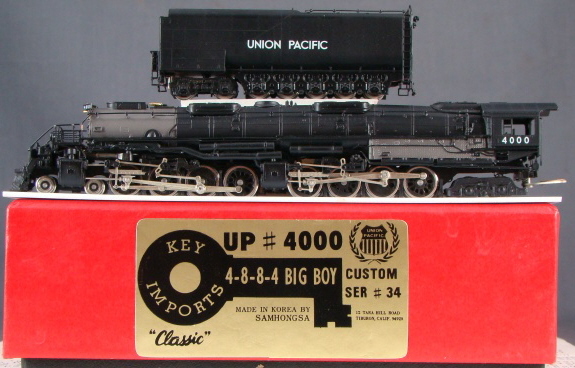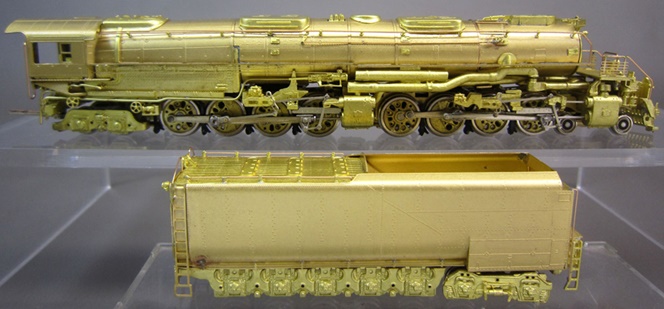

Introduced: 1985
These Key Big Boys are extremely rare, with just the one production run back in 1985 (and limited to just two numbers - #4000 and #4020). A second run was announced in 2004, but apparently never came to fruition. Internally, these models are similar in most respects to the Key/Samhongsa SP Cab-Forwards that were released the following year (the main difference being that the Big Boys use coiled suspension springs whereas the Cab-Forwards use leaf suspension springs).
Not surprisingly, the mechanism is an extremely complex affair -

The two-part chassis is all metal and fairly minimalistic (with most of the actual heft being provided by the shell). The forward portion of the chassis is held in place by three articulated steam lines (and is thus free to pivot). The rear portion of the chassis is fixed in place (IE screwed to the shell). A short/flat metal bar is screwed to both engines and serves to hold them together.
The motor is a closed-sided Sagami #1425 "can" (and presumably a 3-poler). Right-rail pickup is provided by the eight right-side drivers. Left-rail pickup is provided by the seven left-side tender wheels. The rest of the drivers (along with the pilot and trailing trucks) are electrically neutral. Current is transferred from the tender to the engine by way of a stiff wire on the locomotive drawbar (and from said drawbar to the motor by way of a short insulated wire). Driver current flows through the engines (with current from the forward engine flowing through the locomotive shell courtesy of a flexible metal contact mounted in front of its wormbox). A short wire soldered to the torque-arm motor mount on the rear engine transfers chassis current to the motor. Unlike the Cab-Forwards, these Big Boys do not have working headlights or traction tires.

The driveshaft design is a bit unusual, what with it extending at a downward angle from the motor to the rear engine's wormbox, and then continuing on (also downward) to the forward engine. The various metal driveshafts are connected together via a series of plastic U-joints. Only one axle per engine is geared (with all the rest of the drivers being turned solely by the running gear). Said gears can be accessed by removing the rounded shrouds on the bottom of the chassis. All gearing is metal. Each axle is held in place by bearing blocks, and each bearing block has a tiny spring between it and the chassis (providing both downward pressure as well as a bit of up-and-down flexibility).
A fixed (IE, non-operational) coupler is mounted to the pilot. There is no coupler on the tender (although a Micro-Trains friendly pocket is provided).

Overall performance on these models is quite excellent (especially considering the era in which they were produced). Despite the antiquated drawbar wire design (usually a source of trouble), throttle response is smooth and pickup is flawless. The motor is a little whiny, but other than that these models run relatively quietly. Slow speed creep is decent, although owing to the relatively low-tech motor it's not really capable of the "one-tie-at-a-time" creep speeds one finds on more modern steamers. The top-end speed seems a bit excessive, but that's a minor quibble. Pulling power is strong, with mine easily able to pull 50+ freight cars on level track.
One oddity I ran into with mine is that the rear axle-gear shroud hangs down low enough to allow it to nick the crossrails on my Kato Unitrack double crossovers (thus resulting in a short circuit). I was able to solve this by simply filing the shroud a bit flatter (and thus adding some distance between it and the rails). Oddities aside, my main "issue" with these models is that they are only happy on super broad curves. I don't know what the absolute minimum radius might be, but my sample derails on even 19" curves (albeit 180 degrees). This, I suppose, due to the fact that the rear engine is not articulated. So although gorgeous looking models that perform admirably, they're really only going to be operable on layouts with very broad curves (the broader the better, but my guess would be something like 24"-radius at a minimum).
Trivia - Undecorated units were also produced as part of this release (although evidently not very many as I've only ever seen one of them) -

To remove the rear chassis/engine, first remove the two small screws on the rear/underside of the chassis that hold it to the shell (underneath the trailing truck). Next, remove one of the screws that holds the chassis connector bar in place (either one, it doesn't matter which). The rear chassis should lift out readily at that point. To remove the forward chassis/engine, first remove the two small screws that hold the articulated steam pipes to the shell. Next, slide the chassis backwards (towards the cab) until the central steam pipe pops out of its chassis hole. Note that the driveshaft will separate into two halves during this disassembly process. To get the two halves connected back up during reassembly you have to line up the notched tube on the one end with the slotted cup on the other end and then slide it on in (oh yes, lots and lots of fun).
Grades: A (if you have very broad curves) or F (if you don't)